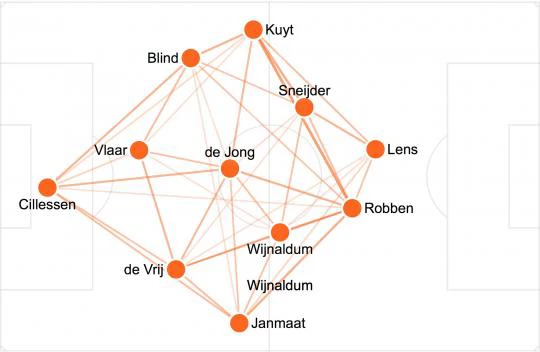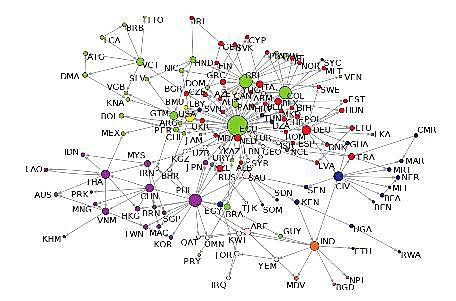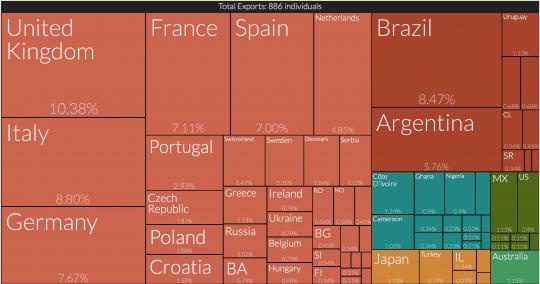
I have to confess I am indifferent to soccer. Until last week, I was mostly annoyed by the distraction brought by the current World Cup.
And then things changed a bit. Reading Le Monde, I was intrigued by a graphical representation of a complex network. It just so happened to be a representation of the strategy of the Dutch soccer team. This is a simple and clever representation, which—at least, for me—makes soccer interesting.
The strength of links between players, with the darker lines corresponding to stronger links, is proportional to the number of passes during the game. This representation allows you to use network tools and metrics to characterize the team and the role of individual players. Some players, it appears, are more central than others. A paper, “A network theory analysis of football strategies,” provides details.
Now I think I understand what soccer is truly all about: the team is the (first) eigenvector of the matrix of passes!
Incidentally, a friend and fellow World Banker—who strangely enough plays the game and is writing books on the socio-economics of soccer (but he calls it football)—confirmed that, indeed, coaches take these tools very seriously.
One may argue that the above graph is merely a basic representation of a team as a social network, and that the tools used are two generations old. True. But this example shows that network analysis of complex (or not so complex) economic, natural or social situations is becoming increasingly accepted and widely used.
The data necessary for this type of analysis is also increasingly available. Beyond the records FIFA collects of passes between players, there’s a tremendous amount of data out there—so much so that it can become overwhelming. For example, we in the World Bank’s International Trade Unit are working with the Universal Postal Union to look at the connectivity of international postal networks. In that project, we deal with hundreds of millions of bilateral events recorded by hundreds of offices worldwide.
Economist may be still lagging behind soccer coaches in terms of mastering complexity and applying its tools. But awareness of the importance of interconnectedness and network structure is growing among us practitioners in international and development economics. We are beginning to apply it to many practical and conceptual areas of our work—in finance, trade, transport, private sector, risk management, governance, and so on. In a seminar in early June we discussed how complex network can help policymakers visualize the structure of world trade in bananas!

Learning on the field (and in the office)
Just a few weeks ago, our trade group teamed up with colleagues at the International Monetary Fund to host “A short course on networks and economic complexity.” The course was over-registered by 150 percent – evidence of the motivation of the small, but fast-growing, community of practitioners.
Professor Cesar Hidalgo of the MIT Media Lab gave the presentation. You can watch some of it yourself here. For me, this was real entertainment. Prof. Hidalgo did a fabulous job balancing complex ideas with practical applications. He even made participants enjoy brushing up their math. (One said, “From an IFC context, it is the first seminar I've been to where equations are discussed "en plein air.")
Quite some conceptual ground was covered: dynamics of network formation, network contagion, network structures, and how to measure the roles of some nodes (soccer players, for example) vis à vis the others. The discussion ranged from complex data sets to simple household data. At one point, Prof. Hidalgo took us through the network structure of his email account—something you can try with your own gmail. So, if you're like me and soccer isn’t your thing, here are a couple of fun, fresh examples of networks that the MIT Media Lab has introduced.
The Pantheon (http://pantheon.media.mit.edu) is an atlas of cultural complexity. This is truly a fantastic source of knowledge. My kids love it! It relates famous individuals with their thematic contribution and geography—simple but brilliant. I found comfort in the fact that my own country, France, still beat others in math (though not soccer, of course).

Source: MIT Media Lab (http://pantheon.media.mit.edu/treemap/domain_exports_to/SOCCER%20PLAYER/all/-4000/2010/H15/pantheon)
Data Viva (http://dataviva.info), is a collection of over 100 million interactive visualizations of the Brazilian state of Minas Gerais economy’s formal sector. It was developed to provide policymakers and the general public with easy-to-understand data on exports, industries, locations, and occupations.
An interdisciplinary transformative approach to development economics?
Visualization of data is great fun whether for soccer, math, or bananas. But maybe the most important message that Prof. Hidalgo tried to convey is more philosophical. What the language of complex networks does is reconcile natural sciences with social sciences. It brings some of the experimental approach of the former into the latter. Its focus is looking for patterns and structure rather than just correlations. This is where the approach of network, complexity, and connectivity can be transformative for development economics.
But there are caveats. One source of healthy skepticism, if not frustration, is that the applications so far emphasize representation rather than a new understanding of economic interactions. They often stop at visualization, for instance, instead of pushing through to new models that might explain concepts, such as contagion in economics. Maybe soccer coaches have the same challenge.
Prof. Hidalgo argued convincingly for the predictive power of networks and complexity in economics, explaining his own contributions to the field, which can be found here. Economic complexity establishes patterns of sophistication of production, which evolves according to development. Under this theory, which is familiar to experts in trade and competitiveness, products are nodes on a complex networks and are linked according to evolutionary patterns.
Networks grow by increasing the number of links between individuals, then between clusters, culminating in fully connected networks. This is exactly what is happening in the growing community of networks practitioners among us. Network theory cuts across many different professional practices: finances, education, governance, private investment, transportation, trade. Finding networks-based solutions to development problems is not only possible, it’s in demand. Countries are asking for it. They want to improve the connectivity of transport systems to maximize the return on investment. They want to ensure that buyers are connected to sellers, physically, financially and even socially.
Maybe in the future the World Bank Group will be asked to develop solutions to benchmark and improve the performance of soccer teams. For the time being, let the fans root for their favorite eigenvector!



Join the Conversation